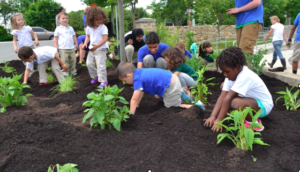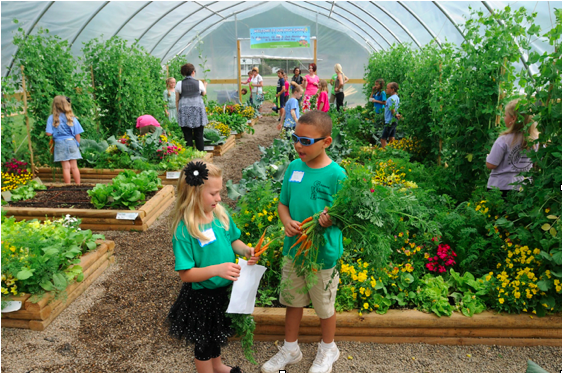
Garden as a teaching tool for students
School gardens are crop-landed areas near or adjacent to schools that are partially tended to by students. Students grow mainly vegetables and fruits, their activities may also include small-scale livestock, fish farming, beekeeping as well as the cultivation of ornamental and shadow plants. The student garden may even include the small-scale production of basic food products.

Governments are becoming increasingly interested in creating school gardens and new and innovative tools for teaching. In this regard, you may want to check this link to learn about the new tech tools that teachers can apply in class.
Traditionally, gardening facilities are used for the purpose of science education, agricultural education or even for a source of additional income. Today, taking into account the urgent need to improve food security, protect the environment, create more reliable livelihoods and improve the nutritional value of our diets, the concepts concerning the feasibility of school gardening facilities are rapidly changing. Some roles that are gaining popularity lie in promoting healthy eating, developing life skills and environmental literacy of students. We believe that planting with students and school gardening facilities, in general, can become the basis for a better understanding of the health and safety of the whole nation.
The potential of school gardening facilities
our young students need the proper nutrition in order to grow, learn, have immunity to diseases, and also the needed strength for everyday life. For their future and the future of their children, they need not only to eat well, but also to learn how to grow this valuable resource themselves, if it ever became necessary.
Schools are a unique opportunity to teach gardening, because at this age children are more open to new ideas and are young enough to adopt to these good habits and new skills easily. With the right conditions and proper support, school gardening facilities will be able to:
- Show students how to grow a variety of foods: vegetables, fruits, legumes, and do it with a proper understanding of their nutritional values;
- Visualize to students how they can expand and improve their diets with the help of products they produce themselves;
- Help facilitate the preference given by students to fruits and vegetables, as well as increase their daily consumption;
- Promote or restore horticultural skills in agricultural economies;
- Diversify school meals rich in trace elements provided by these homegrown fruits and vegetables;
- Promote the development of entrepreneurial skills in the field of gardening;
- Raise awareness needed for improving environmental protection and soil conservation.
Tasks and secrets of success
The teaching of school landscaping is different from most other educational courses such as literature class. While on the context of literature, here at assignment help in Australia prepared for you many interesting and useful articles. So, gardening is multisectoral and interdisciplinary; it is closely related to school meals; classes are often partially optional; it may require some specialized equipment and infrastructure to support the process. In particular good water supply, gardening facilities and orchards may require some care outside of the academic semester.
Other important issues include the need for specialized knowledge and training in the management of gardening; the integration of curricula; performance monitoring and evaluation; as well as support and encouragement for the diligent school staff on this matter. All of this points to the need for careful planning and long-term gardening support, rather than the making hasty decisions.
Benefits of using landscaping as a teaching tool for students

Environment. Engaging the students in horticultural activities has demonstrated an improvement in their attitude toward the environment, especially when organic approaches are used that create a more practical understanding of the environment and its ecosystems.
School nutrition. Although a school garden is not capable of supporting the entire schools needs, it can help by introducing into the main diet of the students cereals, legumes and oils, fruits and vegetables, which are important for the preservation of health. A healthy diet can then be extended beyond the schools walls.
Education. Through both success stories and failures, the decisive importance that education has to eliminate ignorance, erroneous views, incorrect methods and insufficient qualification becomes more and more evident. It is obvious, for example, that in both rich and poor urban conditions, direct experience in the production of food products is being lost or forgotten. In addition, most people (including educated ones) simply do not recognize the connection between proper nutrition and good health. Many erroneous social beliefs about the importance of food affect everyday life and can be refuted by teaching students the key benefits of rational nutrition through the process of gardening.
Gardening and nutrition education: a winning combination
Studies indicate a strong link between gardening when used as an educational tool and the process of learning in the field of nutrition and nutritional values.
There is growing evidence that food production alone does not have a significant impact on the eating habits of students, unless it is supported by proper nutrition education. On the contrary, the combination of teaching rational nutrition and how to grow vegetables has proved to have a positive effect on students’ diet.
Similarly, there is much evidence that teaching only the theory of nutrition rarely results in the student practicing this later in life with a healthy diet of their own. On the other hand, the direct experience of gardening can contribute to children opting for vegetables and thus proper nutrition and adopt a proper diet in the future.